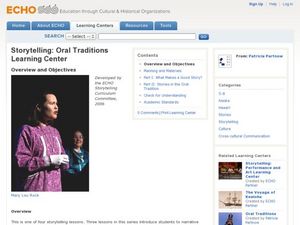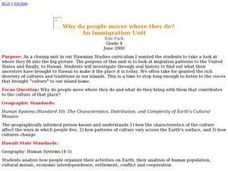Curated OER
Storytelling: Oral Traditions Learning Center
Students explore the oral traditions. In this storytelling lesson, students compare and contrast stories from the cultural traditions of Alaska and Hawaii.
Curated OER
Aloha From the King
Through this activity pupils learn about King Kamehameha I, and letter writing. It begins with an overview of Hawaiian history, with an emphasis on King Kamehameha I, and then goes on to a letter writing activity. Each person writes a...
Curated OER
Hawaii: State History
In this Hawaii state history worksheet, 4th graders read three pages of state history then complete 10 true and false questions.
Curated OER
World Creation Myths
After reading creation myths from around the world, use this quiz to test your learners. Five different myths are covered in a multiple-choice format. Increase your scholars' global awareness by studying world literature and cultural myths.
Google
Google Translate
Not sure how to translate a word, phrase, or paragraph? No worries. Simply paste in, type, or dictate your text, select the initial and desired language, and up pops your translation. Better yet, the app will read the text to you in most...
Curated OER
The Overthrow of the Hawaiian Monarchy
Eighth graders discover details about the overthrow of Queen Liliuokalani. In this Hawaiian history lesson, 8th graders watch "Hawaii's Last Queen," and read Hawaii's Story by Hawaii's Queen. Students reply to discussion...
NOAA
Exploring Potential Human Impacts
Arctic sea ice reflects 80 percent of sunlight, striking it back into space; with sea ice melting, the world's oceans become warmer, which furthers global warming. These activities explore how humans are impacting ecosystems around the...
Curated OER
East Timor: The World's Newest Country
This isn't just a hand-out or a reading passage; it's more like a mini book on the history, colonization, independence, and culture of the South East Asian country of Timor. There are extensive readings and discussion questions for...
NOAA
Ocean Exploration
Sea explorers and scientists have found that because of temperatures being two to three degrees Celsius at the bottom of the ocean, most animals are lethargic in order to conserve energy. In this web quest, pairs of learners read about...
National Museum of the American Indian
To Honor & Comfort Native Quilting Traditions
"Native American history leaps boldly off the colorful quilts and patchwork designs." Learners discuss Native American identity and symbolism by reading about a variety of Native quilters and their unique art process, and participate in...
Curated OER
What Happened?
Students read legends about volcanoes. They develop their own legend and shares them with the class. They practice their writing skills as well.
Curated OER
We Were Here First
Students explore the legal and historical experience of native peoples living in the United States. They write a letter to their United States senator commenting on the Hawaiian bill using information gathered during their research.
Curated OER
Living With Risk: The Human Element of Natural Disasters
Students explore human elements that are a part of natural disasters, read a Hawaiian myth, conduct a survey, discuss why people choose to live in high risk areas, and participate in a writing activity based on studenT real life accounts...
Curated OER
Why do people mover where they do?
Young scholars read factual stories of migration to Hawaii, analyze and explain push and pull factors, interview parents about their cultural heritage, identify countried of origin of their ancestors, graph migration patterns on an world...
Polar Trec
Talk Story: A Native Way of Knowing
The steps of the scientific method examine a problem, make a prediction, and attempt to solve the problem—similar to the path most stories take. In the activity, individuals see how stories can explain natural events similar to the way...
Curated OER
Hawaii
Fourth graders become knowledgeable about Hawaii the state and Hawaii the island. They also work on reading maps of the islands. They come to know the customs, climates and other fun little facts. They also come to know the eight islands.
Curated OER
What is a Dry Forest?
Students explore the importance of the dry forest. For this science lesson, students discuss the history of dry forests and changes that have occurred due to human interaction. Students create a map showing the historical range of the...
Curated OER
Imperialism
In this U.S. history worksheet, students read assigned textbook pages regarding Imperialism and respond to 45 short answer questions.
Curated OER
Surprise at Pearl Harbor
Students review the concept of courage and relate it to their daily life. As a class, they are introduced to the events of December 7, 1941 at Pearl Harbor. Using a map, they locate Hawai'i and label the islands. They use the internet to...
Curated OER
Why Are Volcanoes Dangerous?
Students investigate the causes and characteristics of volcanic eruptions including pyroclastic eruptions. They study the effects of natural disasters.
Curated OER
Animal Adjectives
In this animal adjectives worksheet, learners write an animal next to each adjective, write sentences with the adjectives, and answer short answer questions about adjectives. Students complete 5 activities total.
Curated OER
Taro
Young scholars locate taro growing areas on a map and how it got there, explain intercultural contact and how taro has been adapted in Hawaii and trace human/taro migration to Hawaii.
Other
Hawaii history.org: Ancient Hawai'i
Discover information about the earliest times in Hawaiian history through a timeline of events pertaining to the birth of this island. Read comprehensive facts about Hawaii's sophisticated culture including food, recreation, worship and...
Other
Go Hawaii: The Story of King Kamehameha I
Read the legend of King Kamehameha I, Hawaiian warrior, diplomat, and leader, while learning about the four statues build to honor his memory.

























